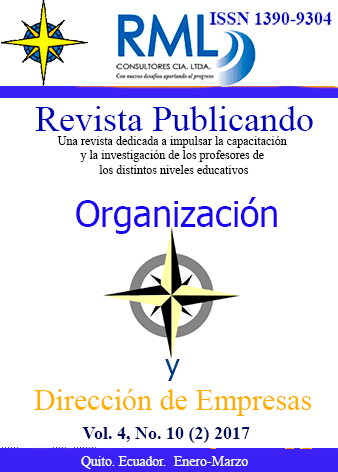Abstract
En términos de las ciencias económicas y empresariales, la auditoria forense es una ciencia que permite reunir y presentar información financiera, contable, legal, administrativa e impositiva, en una forma que debe ser aceptada por una corte de jurisprudencia contra los perpetradores de un crimen económico, por lo tanto, existe la necesidad de preparar profesionales con visión integral, que faciliten evidenciar especialmente, delitos como: la corrupción administrativa, el fraude contable, el delito en los seguros, el lavado de dinero y el terrorismo, entre otros.
En esta publicación se realiza un análisis a partir de una revisión bibliográfico del posible estado de las investigaciones en el área de las auditorias forenses. Para alcanzar este objetivo se desarrolló una búsqueda en el directorio Scopus; y, con las herramientas biométricas que este potente directorio se presentan los resultados.
Se destacó el creciente interés en el estudio y perfeccionamientos de las auditorias forenses a nivel mundial. Por otra parte, las investigaciones indican que una cultura corporativa que se centra en la línea de fondo junto con controles internos débiles o inexistentes, propician condiciones que generan fraudes contables y financieros.
References
Digabriele, J. A. (2009). Implications of regulatory prescriptions and audit standards on the evolution of forensic accounting in the audit process. Journal of Applied Accounting Research, 10(2), 109-121. doi:10.1108/09675420910984673
DiMaggio, P. J., & Powell, W. W. (2000). The iron cage revisited institutional isomorphism and collective rationality in organizational fields Economics Meets Sociology in Strategic Management (pp. 143-166): Emerald Group Publishing Limited.
Golden, T. W., Skalak, S. L., Clayton, M. M., & Pill, J. S. (2011). A guide to forensic accounting investigation: John Wiley & Sons.
Gottschalk, P. (2014). Private investigations: Suspicion of financial crime by white-collar criminals: Nova Science Publishers, Inc.
Gottschalk, P. (2016). Knowledge management in criminal investigations: The case of fraud examiners. Journal of Information and Knowledge Management, 15(4). doi:10.1142/S021964921650043X
Kranacher, M.-J., Riley, R., & Wells, J. T. (2010). Forensic accounting and fraud examination: John Wiley & Sons.
Law, P., & Yuen, D. (2016). Professional scepticism in two economies with cultural differences and the public interest: evidence from China and the United States. Applied Economics, 48(2), 89-106. doi:10.1080/00036846.2015.1073845
Lindhardt, T., & Berthelsen, C. B. (2017). h-index or G-spot: Female nursing researchers' conditions for an academic career. Journal of Advanced Nursing, 73(6), 1249-1250. doi:10.1111/jan.12942
Lokanan, M. E. (2014). How senior managers perpetuate accounting fraud? Lessons for fraud examiners from an instructional case. Journal of Financial Crime, 21(4), 411-423. doi:10.1108/JFC-03-2013-0016
Manyanga, T., Tremblay, M. S., Chaput, J. P., Katzmarzyk, P. T., Fogelholm, M., Hu, G., . . . Pietrobelli, A. (2017). Socioeconomic status and dietary patterns in children from around the world: Different associations by levels of country human development? BMC Public Health, 17(1). doi:10.1186/s12889-017-4383-8
Monroe, A. P., Burger, L. W., Jr., Boland, H. T., & Martin, J. A. (2017). Economic and conservation implications of converting exotic forages to native warm-season grass. Global Ecology and Conservation, 11, 23-32. doi:10.1016/j.gecco.2017.04.006
Prathap, G. (2017). Letter to the editor: comments on the paper of Lucio Bertoli-Barsotti and Tommaso Lando: a theoretical model of the relationship between the h-index and other simple citation indicators. Scientometrics, 1-4. doi:10.1007/s11192-017-2404-0
Scott, W. R. (1995). Institutions and organizations (Vol. 2): Sage Thousand Oaks, CA.
Singleton, T. W., Singleton, A. J., Bologna, G. J., & Lindquist, R. J. (2006). Fraud auditing and forensic accounting: John Wiley & Sons.
Zamzami, F., Nusa, N. D., & Timur, R. P. (2016). The effectiveness of fraud prevention and detection methods at universities in Indonesia. International Journal of Economics and Financial Issues, 6(3), 66-69.
You are free to:
Share — copy and redistribute the material in any medium or format.
Adapt — remix, transform, and build upon the material.
The licensor cannot revoke these freedoms as long as you follow the license terms.
Under the following terms:
Attribution — You must give appropriate credit, provide a link to the license, and indicate if changes were made. You may do so in any reasonable manner, but not in any way that suggests the licensor endorses you or your use.
NonCommercial — You may not use the material for commercial purposes.
ShareAlike — If you remix, transform, or build upon the material, you must distribute your contributions under the same license as the original.
No additional restrictions — You may not apply legal terms or technological measures that legally restrict others from doing anything the license permits.
